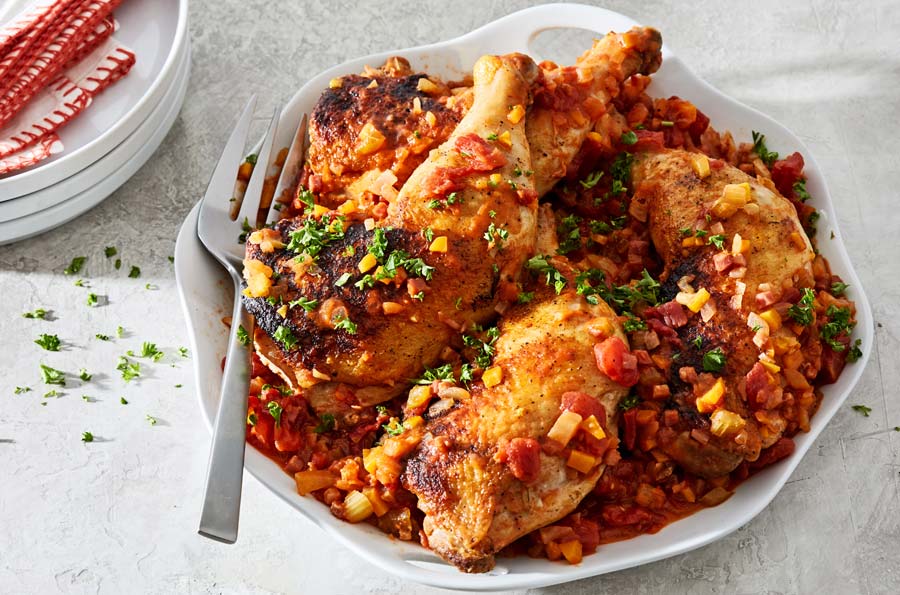 Stacy Zarin Goldberg; food styling by Lisa Cherkasky; both for The Washington Post
Stacy Zarin Goldberg; food styling by Lisa Cherkasky; both for The Washington Post
As with many braises, the flavors and textures are even better on the second day. You can pick the meat off the bones and serve the chicken and sauce on pasta or polenta.
![]()
CHICKEN SAUTE WITH TOMATOES, KOSHER PANCETTA AND A KISS OF VINEGAR
MAKES: 4 servings
MAKE AHEAD: As with many braises, the flavors and textures are even better on the second day. Leftover meat from the chicken can be served with the sauce over pasta or polenta.
Ingredients
- 4 whole chicken legs (about 2 pounds total; may substitute 4 skin-on, bone-in chicken thighs plus 4 drumsticks)
- Kosher salt
- Freshly ground black pepper
- 2 tablespoons extra-virgin olive oil or vegetable oil
- 1/2 medium onion, finely chopped (1/2 cup)
- 2 ounces ''kosher pancetta" (Aaron's beef fry), finely chopped
- 2 medium carrots, diced or finely chopped (1/2 cup)
- 2 large ribs celery, finely chopped or diced (1/2 cup)
- 1/2 medium fennel bulb, finely chopped or diced (1/2 cup; optional)
- 4 or 5 garlic cloves, finely chopped
- 1/2 cup vinegar of your choice, as long as it's not sweet
- One 14-ounce can diced tomatoes (may substitute canned whole peeled tomatoes, chopped)
- 1 cup low-sodium or homemade chicken broth
- Few shakes hot sauce
- A few sprigs of fresh thyme and rosemary
- A few parsley stems plus 1/4 cup chopped parsley
- 2 tablespoons cold margarine (salted or unsalted)
Steps
Trim/discard any excess skin or fat from the chicken pieces. Pat dry with paper towels, then season generously with salt and pepper. Heat a tablespoon of the oil in a heavy skillet that's large enough to hold all the chicken in one comfortable layer, until shimmering over medium-high heat.
Add the chicken pieces, skin sides down. Reduce the heat to medium, or whatever temperature keeps the chicken quietly sizzling but not crackling or sputtering - you want to take your time with this step to get a nice deep browning without burning. Cook, undisturbed, for about 10 minutes, or until the skin is deep golden brown. (If you are using separate thighs and drumsticks, turn the latter a few times to brown evenly.) Turn the whole legs over and cook for an additional 4 or 5 minutes. Try not to let the pan juices get too dark, as they will add flavor to the dish - if they seem to be heading that direction, reduce the heat.
Transfer the chicken to a plate or tray to hang out for a minute; pour or spoon off the fat from the pan. (Reserve it to use later for cooking potatoes.) Add the remaining oil to the pan plus the onion and pancetta. Cook for about 5 minutes, until the pancetta has rendered its fat and the onion is soft and fragrant. Scrape the bottom of the pan as you cook, to dislodge any chicken bits.
Add the carrot, celery, fennel, if using, and the garlic (to taste), then season lightly with salt and pepper; cook for about 5 minutes, until those vegetables start to soften.
Pour the vinegar into the skillet, but stand back as you do it - the vinegar will produce some crazy fumes, so keep your face away from the pan. Let the vinegar cook until it's reduced by almost half, then add the tomatoes, broth, hot sauce (not enough to make the dish "spicy," just enough for some sparkle), rosemary and/or thyme, and the parsley stems. Nestle the chicken back into the pan, skin sides up.
Cover the pan; adjust the heat to maintain a gentle bubble until the chicken is cooked all the way through. The temperature of the meat (taken away from the bone) should measure about 175 degrees on an instant-read thermometer. This should take an additional 30 to 45 minutes, depending on the size of your chicken pieces.
To finish the dish, transfer the chicken to a clean platter.
Spoon off any fat from the surface of the sauce, then increase the heat to medium-high so it bubbles vigorously. Cook just until the sauce has thickened and reduced by about one-third. (It will look like a sofrito.) Discard the herb stems. Remove from the heat.
Stir or swirl in the margarine, until it has melted and further thickened (emulsified) the sauce. Taste, and season with more salt, pepper and/or hot sauce, as needed.
Pour the sauce over the chicken. Garnish with the chopped parsley.
The ingredients were too variable for a meaningful analysis.
(COMMENT, BELOW)


 Contact The Editor
Contact The Editor
 Articles By This Author
Articles By This Author